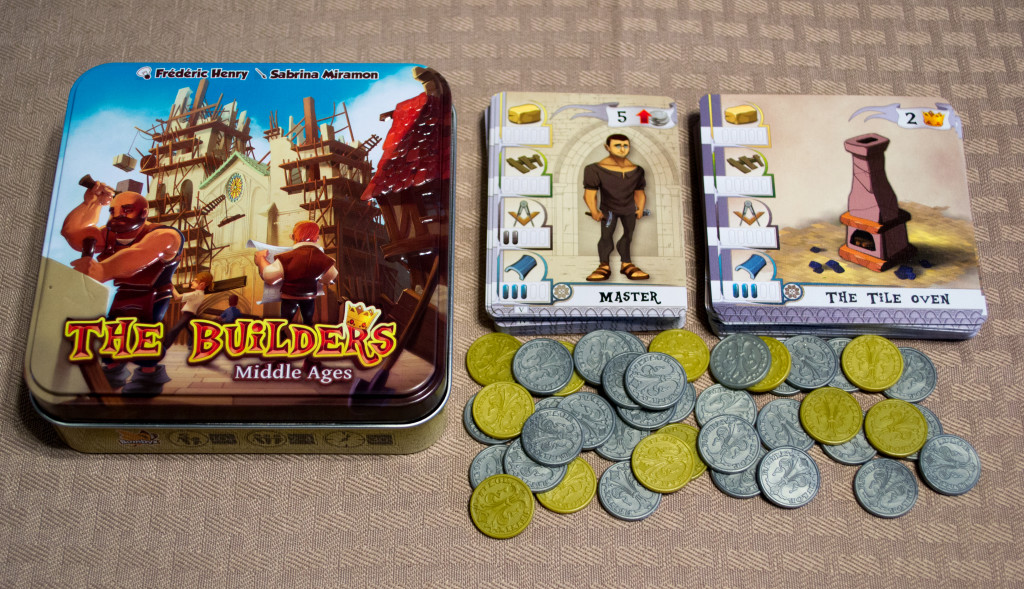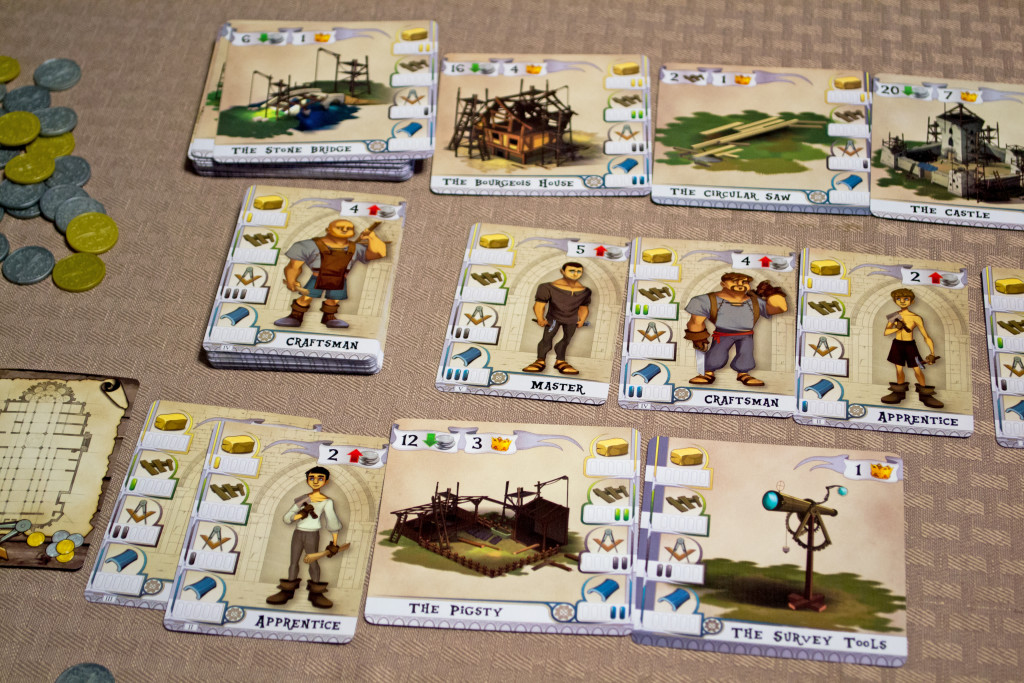I have a rather unhealthy fascination with all things “medieval” and I’m not exactly sure why. Games like “The Elder Scrolls V: Skyrim” that feature swords, bows, and magic are much more appealing to me than a modern-day shooter like “Call of Duty“. “The Builders: Middle Ages” attracted me for that very reason, though the fact that it was a microgame (small package & easy to play) also had something to do with it. It reminded me of “Splendor” in the sense that you’ll be using money to buy cards, which in turn can sometimes be used to buy more cards…though obviously there are a few differences. Let’s quickly take a look, shall we?
Components
Cards – The game includes 42 worker and 47 building cards. Worker cards list a cost for using them, as well as show how many resources of a particular type they contribute to a structure that they are assigned to building. Building cards show how much money and victory points the player earns for constructing it, as well as the resources required to do so. The four resources are stone, wood, knowledge, and tile.
Coins – There are 40 coins: silver is worth “1” whereas gold is worth “5”.
Setup & Gameplay
The building tiles are shuffled and placed into a deck near the center of the table. Five cards are drawn from it and placed side by side, face up, near the deck. Next, each player receives a random apprentice worker card with any leftovers being shuffled into the worker deck. This deck is also placed near the center of the table and five cards are dealt side by side, face up, near the deck. Each player receives ten coins and a starting player is chosen.
A player can take three actions on their turn, though they can buy more by paying five coins to the bank per additional action. These actions include:
1. Start Construction – The player can choose a building from the stock, placing it in front of them. A new building is drawn from the deck to replenish the stock. This costs one action.
2. Recruit a Worker – The player can choose a worker from the stock, placing it in front of them. A new worker is drawn from the deck to replenish the stock. This costs one action.
3. Send a Worker to Work – The player can choose one of their workers from their own stock and assign it to a building, though they’ll also need to pay the cost listed on the worker card. The worker cannot move until the building is complete. This alone costs one action, though adding more workers to the SAME building on the SAME turn requires additional action points (two action points for adding a second worker and three actions points for adding a third worker). Adding a worker to a different building on the same turn doesn’t penalize you in this way.
4. Take Coins – A player can choose to give up one action for one coin, two actions for three coins, or three actions for six coins.
When a player finishes a building, the workers return to their personal stock and the building is flipped over to show that it has been constructed. They also receive the money and victory points as shown on the card. Some buildings are “machines” that can be used to provide resources toward construction…unlike workers, there’s no monetary cost for doing so (though it still costs an action to assign it to a building under construction).
When someone reaches 17 victory points, play continues until everyone has had an equal number of turns. Players then add up their victory points and factor in any money they may have (10 coins worth of value = 1 VP). The person with the most victory points, wins the game!
Note: The above doesn’t cover all of the rules found in the manual, but should give you an idea as to how the game is play.
The Review
In terms of a learning curve, the game was incredibly easy to pick up and play. Those who have played the more recent “Splendor” will get the general idea here rather quickly: draft buildings (I prefer the term “blueprints”) & workers, use workers to construct buildings, profit. If you happen to build a machine or two to assist in the resource production, all the better. There’s a bit more emphasis in chaining cards/resources properly in “Splendor”, I feel, though there’s still enough of the concept here to warrant your attention. “The Builders: Middle Ages” is more like “Splendor” in the sense that you can draft (“reserve”) buildings or workers that other player might be going for in order to ruin their plans.
Along those lines, there’s no limit to how many buildings and workers one can draft. This is where “The Builders: Middle Ages” really begins to set itself apart from “Splendor”. “Splendor” is all about using a finite amount of resources to accomplish your personal goals, and I stress the word “finite”. There’s more room for maneuvering and mistakes in “The Builders: Middle Ages” since you only pay money when you assign a worker to construction…not when drafting. This, coupled with the fact that there are no limits to how many cards one can draft, makes the game play out a little more differently. Of course, you are still racing to get victory points as quickly as you can and spending time drafting cards you won’t actually need could in fact cost you the game.
With that said, is “The Builders: Middle Ages” worth buying? Absolutely. The game offers a lot of replayability for its average asking price, which is about ten to fifteen bucks on Amazon. Like “Splendor”, it hits a nice sweet spot in terms of being easy to learn yet being complex enough for thinkers like myself to enjoy playing. The cards are a bit too thin for my tastes, though the art is nice and themed appropriately. I also would have liked rubber bands or a zip-baggie for the coins…the bag the coins came in was not resealable. All in all, it’s a solid light family-friendly strategy game.
Final Verdict: 8/10
—


